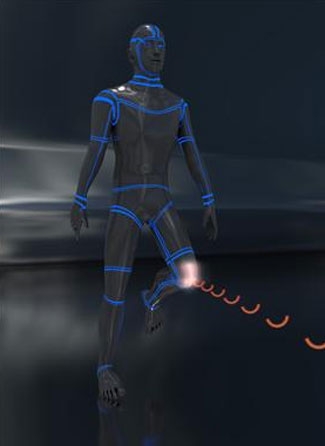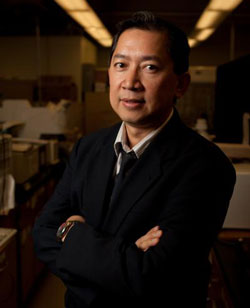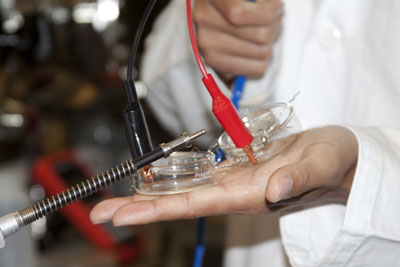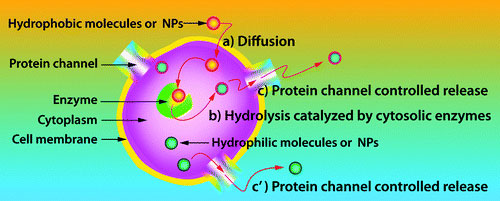 Uppsala researcher Zhigang Wu, working with collaborators, has devised a wireless sensor that can stand to be stretched. For example, the sensor can measure intensive body movements and wirelessly send information directly to a computer.
Uppsala researcher Zhigang Wu, working with collaborators, has devised a wireless sensor that can stand to be stretched. For example, the sensor can measure intensive body movements and wirelessly send information directly to a computer.
Jun 16th, 2011
Read more
Scanning tunnelling microscopes provide insights into mysterious electronic effects in some metals.
Jun 16th, 2011
Read more
Imec and K.U.Leuven have developed a simple double-bead sandwich assay, using both gold and magnetic nanoparticles, for the detection of proteins in serum. The effectiveness of the method was demonstrated by the detection of prostate specific antigen (PSA), which is a marker for prostate cancer.
Jun 16th, 2011
Read more
 Imec researchers have developed a methodology to quantitatively map the distribution of active dopants in confined 3D-volumes. This is an important step towards in-depth understanding of transistors based on semiconductor nanowires. The new methodology is based on high-vacuum scanning spreading resistance microscopy (HV-SSRM).
Imec researchers have developed a methodology to quantitatively map the distribution of active dopants in confined 3D-volumes. This is an important step towards in-depth understanding of transistors based on semiconductor nanowires. The new methodology is based on high-vacuum scanning spreading resistance microscopy (HV-SSRM).
Jun 16th, 2011
Read more
To make solar energy generation cost-effective, the PV industry has to reduce its manufacturing costs well below 1 euro/Wp. This holds for all PV technologies. To reach that ambitious goal, the crystalline Si based PV industry will have to increase the solar cell's efficiency while at the same time reducing the amount of high-purity Si that is used.
Jun 16th, 2011
Read more
Imec and Holst Centre are working on a number of gas sensing technologies, relentlessly scaling the sensor, readout electronics and power consumption. The result will be sensors-on-a-chip, used as standalone e-nose (electronic nose), or as nodes in low-power, wireless sensor networks.
Jun 16th, 2011
Read more
 A University of Houston (UH) chemist who is developing materials for detecting and repelling E. coli has published papers in two high-impact journals this month.
A University of Houston (UH) chemist who is developing materials for detecting and repelling E. coli has published papers in two high-impact journals this month.
Jun 15th, 2011
Read more
New engineering research at the University of Pennsylvania demonstrates that polaritons have increased coupling strength when confined to nanoscale semiconductors. This represents a promising advance in the field of photonics: smaller and faster circuits that use light rather than electricity.
Jun 15th, 2011
Read more
The Food and Drug Administration is opening a dialogue on nanotechnology by publishing proposed guidelines on how the agency will identify whether nanomaterials have been used in FDA-regulated products.
Jun 15th, 2011
Read more
 Today's television programs are designed to trigger your emotions and your mind through your senses of sound and sight. But what if they could trigger a few more? What if you could smell or taste the cheesy slices of pizza being eaten by your favorite characters on TV? Is it possible? Would audiences enjoy the experience? Would advertisers jump on the opportunity to reach consumers in a new way?
Today's television programs are designed to trigger your emotions and your mind through your senses of sound and sight. But what if they could trigger a few more? What if you could smell or taste the cheesy slices of pizza being eaten by your favorite characters on TV? Is it possible? Would audiences enjoy the experience? Would advertisers jump on the opportunity to reach consumers in a new way?
Jun 15th, 2011
Read more
 The quest for better ways of encapsulating medicine so that it can reach diseased parts of the body has led scientists to harness - for the first time - living human cells to produce natural capsules with channels for releasing drugs and diagnostic agents.
The quest for better ways of encapsulating medicine so that it can reach diseased parts of the body has led scientists to harness - for the first time - living human cells to produce natural capsules with channels for releasing drugs and diagnostic agents.
Jun 15th, 2011
Read more
New research at the University of Leicester is using nanotechnology to create energy efficient materials.
Jun 15th, 2011
Read more
University of Leicester researchers are spearheading the development of a novel type of sustainable zinc-based rechargeable battery for electric vehicles (EV) and hybrid EVs.
Jun 15th, 2011
Read more
Prestigious award recognizes promising postgraduate researchers in molecular biology.
Jun 15th, 2011
Read more
The National Nanotechnology Directorate (NND), a unit under the Ministry of Science, Technology and Innovation (MOSTI), will set up a RM200 million NanoMalaysia Centre complex at Senai High Tech Park, Johor.
Jun 15th, 2011
Read more
The Institute of Microelectronics (IME), a research institute of the Agency for Science, Technology and Research (A*STAR) has launched its 11th Electronic Packaging Research Consortium (EPRC11) to address various technology challenges in advanced packaging technology in semiconductor in enabling smaller and smarter devices.
Jun 15th, 2011
Read more
 Uppsala researcher Zhigang Wu, working with collaborators, has devised a wireless sensor that can stand to be stretched. For example, the sensor can measure intensive body movements and wirelessly send information directly to a computer.
Uppsala researcher Zhigang Wu, working with collaborators, has devised a wireless sensor that can stand to be stretched. For example, the sensor can measure intensive body movements and wirelessly send information directly to a computer. 




 Subscribe to our Nanotechnology News feed
Subscribe to our Nanotechnology News feed